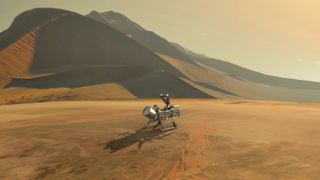
NASA is going to Titan.
The space agency announced today (June 27) that the next mission in its New Frontiers line of medium-cost missions will be Dragonfly, a rotorcraft designed to ply the skies of the huge, hazy and potentially life-hosting Saturn moon.
If all goes according to plan, Dragonfly will launch in 2026 and land on Titan eight years later, NASA officials said. The probe will then spend at least 2.5 years cruising around the 3,200-mile-wide (5,150 kilometers) moon, making two dozen flights that cover a total of about 110 miles (180 km).
Related: Amazing Photos: Titan, Saturn's Largest Moon
The 10-foot-long (3 meters) Dragonfly will gather a variety of data at each of its stops. Such work will help scientists learn more about Titan, the only solar system body other than Earth known to host stable bodies of liquid on its surface.
Titan's surface lakes, rivers and seas aren't composed of water, however: The frigid moon's climate system is based on hydrocarbons, in particular methane and ethane.
The mission is geared toward characterizing Titan's chemistry in detail. Complex organic molecules are known to swirl in the moon's thick, nitrogen-dominated atmosphere, and some scientists think its hydrocarbon seas could host exotic forms of life.
Get the Space.com Newsletter
Breaking space news, the latest updates on rocket launches, skywatching events and more!
Titan also hosts another potentially habitable environment — a buried ocean of liquid water, which sloshes beneath the moon's icy crust.
Dragonfly could conceivably find evidence of Titan life, if the moon is indeed inhabited. And, because Titan is very similar to the early Earth, the mission's observations may shed light on the chemical processes that helped life get going on our planet, NASA officials said.
"Titan is unlike any other place in the solar system, and Dragonfly is like no other mission," Thomas Zurbuchen, NASA's associate administrator for science at the agency’s headquarters in Washington, D.C., said in a statement.
"It's remarkable to think of this rotorcraft flying miles and miles across the organic sand dunes of Saturn's largest moon, exploring the processes that shape this extraordinary environment," he added. "Dragonfly will visit a world filled with a wide variety of organic compounds, which are the building blocks of life and could teach us about the origin of life itself."
Dragonfly will land among Titan's dunes, then make its way toward its final destination, the 50-mile-wide (80 km) Selk Crater. Selk is a particularly good place to study prebiotic chemistry and look for signs of life, NASA officials said. That's because the three ingredients necessary for life as we know it — liquid water, organic molecules and energy — mixed during the impact that created the crater. (Titan's bedrock is water ice.)
Dragonfly will be nuclear powered, like NASA's Mars rover Curiosity, the New Horizons Pluto probe and many other deep-space explorers.
Dragonfly will be the fourth mission in the New Frontiers program, following New Horizons, the Juno probe to Jupiter and the OSIRIS-REx asteroid-sampling mission. Dragonfly's development costs are capped at $850 million, though the mission's total price tag, including launch, will probably top $1 billion.
The other finalist for the mid-2020s New Frontiers launch slot was the Comet Astrobiology Exploration Sample Return (CAESAR) mission, which proposed snagging bits of Comet 67P/Churyumov-Gerasimenko — the same icy wanderer studied up close by Europe's Rosetta mission.
Dragonfly won't be the first craft to land on Titan. That honor belongs to Europe's Huygens probe, which touched down on the moon in January 2005. Huygens traveled to the Saturn system with NASA's Cassini spacecraft, which orbited the ringed planet from mid-2004 through September 2017.
- Landing on Titan: Pictures from Huygens Probe on Saturn Moon
- The Rings and Moons of Saturn (Photos)
- In Photos: Cassini Mission Ends with Epic Dive into Saturn
Mike Wall's book about the search for alien life, "Out There" (Grand Central Publishing, 2018; illustrated by Karl Tate), is out now. Follow him on Twitter @michaeldwall. Follow us on Twitter @Spacedotcom or Facebook.
Join our Space Forums to keep talking space on the latest missions, night sky and more! And if you have a news tip, correction or comment, let us know at: community@space.com.

Michael Wall is a Senior Space Writer with Space.com and joined the team in 2010. He primarily covers exoplanets, spaceflight and military space, but has been known to dabble in the space art beat. His book about the search for alien life, "Out There," was published on Nov. 13, 2018. Before becoming a science writer, Michael worked as a herpetologist and wildlife biologist. He has a Ph.D. in evolutionary biology from the University of Sydney, Australia, a bachelor's degree from the University of Arizona, and a graduate certificate in science writing from the University of California, Santa Cruz. To find out what his latest project is, you can follow Michael on Twitter.